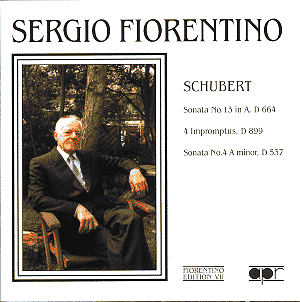Fiorentino’s
recordings on APR have been well-received so far, and justifiably
so, if this disc is anything to go by. Fiorentino died in August
1998 and so these performances reflect some of the fruits of his
maturity. Indeed, they are imbued with the golden glow of the
sunset of a life filled with dedication to great music. Everything
is carefully considered, and Fiorentino easily and naturally fits
in with those who do most to further the cause of the Schubert
piano sonatas.
The
A major Sonata, D537 (with which the disc begins) is very much
music of daylight. Fiorentino eases in beautifully, obviously
at home in the prevailing serenity. Indeed, the more confrontational
octave exchanges around 4’40 in the first movement sound decidedly
repetitive and out of place here. The second movement is quite
slow for its Andante marking, but Fiorentino avoids over-indulgence;
yet it is in the finale that he really shows his credentials,
capturing the deceptive simplicity to perfection.
The
A minor Sonata, D537, is similarly distinguished. The tempo for
the Allegro ma non troppo is well chosen: the momentum generated
imbues the whole with a joyous undercurrent. Rhythms are full
of life (almost dancing), while the more dramatic gestures are
given their due. A dreamy Allegretto quasi Andantino is touchingly
delicate, while the scampering finale is nevertheless carefully
thought through and sculpted.
The
Four Impromptus, D899, always provides an interpretative challenge.
The first (C minor), while not technically challenging, can seem
over-long in the wrong hands. Not these hands, though: the annunciatory
forte has real point and Fiorentino displays great sensitivity.
Although it flows along nicely, there is an accompanying grandeur
which is most fitting.
In
all four of these impromptus, careful voice-leading is essential.
Fiorentino shows this, not only in the latter parts of the first,
but also in the dreamy third (G flat), where clear elucidation
of inner parts helps fend off any tempting over-romanticism. The
only complaint comes with the second (in E flat) which, although
fluent, is not liquid, Fiorentino attempting to give each note
its own life, perhaps too much so.
Certainly
this should not put anyone off investing in a most rewarding issue.
Superb booklet notes from Bryce Morrison are included. This disc
is a winner.
Colin
Clarke
